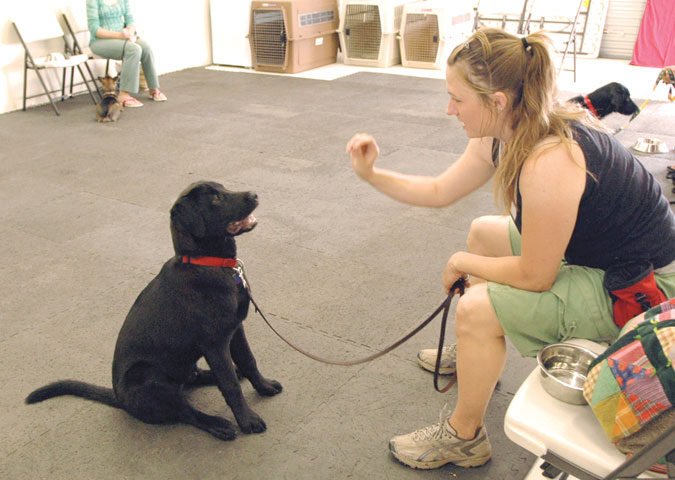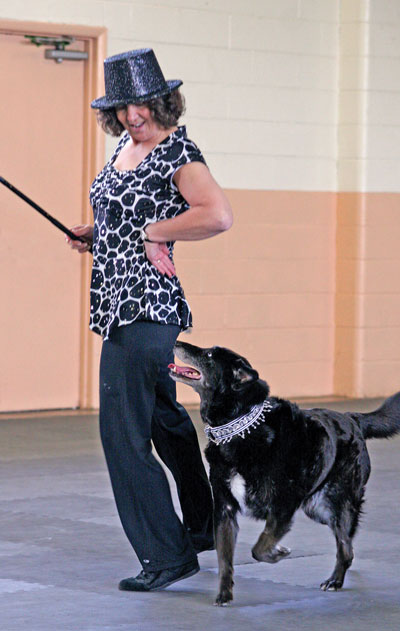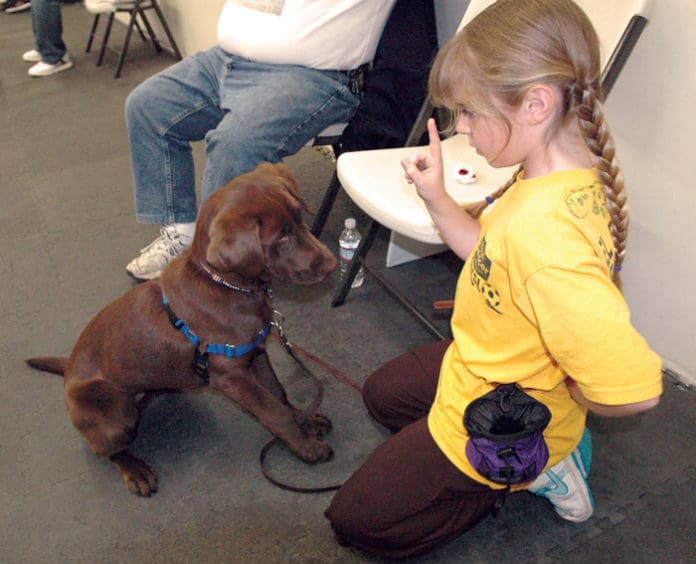Anyone who has ever learned to do something physical – hitting a baseball, sewing a garment, driving a car, you name it – understands that you gain competence only through practice and repetition. At first, your movements and timing are clumsy and imperfect. You probably overcorrect, making crooked or zig-zagging seams or driving the car over the centerline bumps. But over time – and especially if you have some expert guidance – your movements become smooth and coordinated, and it seems to any observers that you’re a natural! Ha! If only they could see you at the beginning!
Learning new skills is hard work – for people AND dogs
Now, think about learning something new with a partner who is also learning the same skill, such as a new dance or perhaps sign language. The difficulty factor goes way up! It’s going to take a bit longer for the result to look smooth.

Now imagine that your dance partner or sign language conversation partner speaks a different language! If this is the case, all of your clumsy efforts require that much MORE patience, creativity, and humor with each other as you try to figure out how to communicate while simultaneously managing intricate dance steps or movements of the hands.
This latter scenario, you may have already guessed, is exactly what’s at play with new dog owners and their new dogs or puppies!
Every new owner wants their puppies or dogs to behave well – to stop doing uncomfortable or naughty things like chewing shoes, jumping on people, or barking at the leaves falling in the back yard, and to perform good behaviors on cue, such as sit, down, wait, and leave it. It adds quite a layer of difficulty to teach them to do what we want, in a language that is not their own, while we are simultaneously learning to use our posture and movements (body language!) for cues and the timely delivery of reinforcers!
Using markers and reinforcers
In the late 1940s, pioneering animal trainers Keller and Marian Breland started teaching other animal trainers to use a marker and the immediate delivery of a reinforcer to teach animals to perform behaviors. They found that chickens were a great species to use to help trainers learn the physicality of cues and reinforcement delivery – especially, the timing of the marker and reinforcer delivery, as well as the location and presention of the both the cue and the reinforcer.
Chickens who were raised around people aren’t afraid of humans, they notice very minute differences in the appearance of things, they are very quick to react when they notice these differences, and they are very motivated by food to try new behaviors. They also don’t carry a lot of behavioral “baggage” along with them, resulting from living with sometimes-intemperate humans! They make amazing practice partners for anyone who is learning how to observe animal behavior and learn to change it swiftly and without force, and there is a long legacy of trainers who still use chickens to teach dog trainers how to refine and improve their training technique.
Don’t blame the chicken!
Another brilliant thing about using chickens to teach people how to train: people don’t get mad at chickens when they are failing to get the chicken to perform a specific behavior! They don’t tend to start calling the chicken “stubborn” or “spiteful” – or blame the chicken’s breed, origins as a “rescue chicken” or anything else. They are able to easily see that training the chicken is just a matter of presenting the training challenge to the chicken in a precise way that makes it easy for the chicken to do the behavior (or some approximation of it), for the behavior to instantly be “marked” (with the click of a clicker or a verbal marker, such as the word “Yes!”, or the flash of a penlight, or what have you!) and be reinforced for it immediately.
They are also able to see that if they are late with the marker, or fail to deliver the reinforcer in a timely fashion and in a location that doesn’t pull the chicken out of the position the trainer wanted her in, that it’s impossible for the chicken to “get” the point of the exercise! They see that it’s their own clumsiness or bad timing, not the chicken being “bad.”
Get a second set of eyes

If you are having trouble teaching your dog some new behavior, consider taking a little video of yourself as you work with your dog, or ask someone who you consider to be a good trainer to watch you. It might develop that you simply need a little coaching on how you are presenting the cue, or marking the desired behavior, or delivering the reinforcer. Strike that: It is undoubtedly a problem with one of those things, not that your dog is being dumb, lazy, or a non-native speaker of English.
Honestly, if you are motivated to learn how to more effectively teach your dog new behaviors quickly, sign up for a class or even just a private lesson or two with someone who is experienced with positive reinforcement-based training (and who does NOT use punitive, physical “corrections” AT ALL). With a few pointers, you will be amazed at how quickly you and your dog or puppy will be happily speaking the same language as you dance through life together.






I live in New York City with my Aussie, Lily. She is very good at everything obedience-wise, but I simply CANNOT get her to the curb before she pees. I’ve tried treats, I’ve tried pulling her (which just leaves a trail of pee)–nothing seems to work. I always run with her in an attempt to reach the curb, but she always stops in the middle of the sidewalk and lets loose. I take her out many times a day, so it’s not a matter of her not having enough opportunity. Lily is now ten years old (!!!). Are there any suggestions for altering her behavior?
Many thanks.
Maybe you are waiting too long between walks.
You dog is old and probably has poor balder control. iin my dotage all I have to do it THINK “I need to pee” and I will wet my pants 🙁
How do I stop him from eating his pooh. He is 3 months and is a german sheppard. But he insists to eat it after he does it. I have to actually run to stop him. He also bites everything he can get his hands on.
One of our dogs did the same. I starting bringing extra hot hot sauce on walks and quickly doused the pooh with it (a sprayer works great if you find the right one). Timing is everything! The first time, it didn’t seem to phase her right away, that is! She did some serious mouth moves with her tongue as if trying to erase the taste. The second time she was very cautious but still proceeded to do her thing. The third time she was very cautious and started carefully sniffing before grabbing at it. By the fourth time, she started sniffing from a distance. Admittedly, it took a few months before her curiousity and appetite diminished to finally become disinterest. It was well worth the effort!
What do you do with the chicken when you finish training it? Do you grill it or fry it?
What are your thoughts on e-collars? Do you consider them punitive or punishment based?
As I was reading your posts, those days suddenly came back to me. The joy of having dogs as my companion and the sad part of losing them when they died..I have new pets now, a dog and a cat, this helped me a lot bit.ly/dog_star might do wonders to you as well. keep posting.